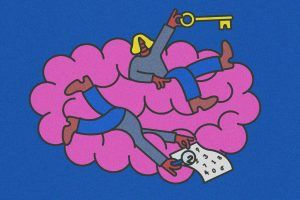Bryan Clark in The New York Times:
 You slide the key into the door and hear a clunk as the tumblers engage. You rotate the key, twist the doorknob and walk inside. The house is familiar, but the contents foreign. At your left, there’s a map of Minnesota, dangling precariously from the wall. You’re certain it wasn’t there this morning. Below it, you find a plush M&M candy. To the right, a dog, a shiba inu you’ve never seen before. In its mouth, a pair of your expensive socks.
You slide the key into the door and hear a clunk as the tumblers engage. You rotate the key, twist the doorknob and walk inside. The house is familiar, but the contents foreign. At your left, there’s a map of Minnesota, dangling precariously from the wall. You’re certain it wasn’t there this morning. Below it, you find a plush M&M candy. To the right, a dog, a shiba inu you’ve never seen before. In its mouth, a pair of your expensive socks.
And then it comes to you, 323-3607, a phone number.
If none of this makes sense, stick with us; by the end of this piece you’ll be using the same techniques to memorize just about anything you’ve ever wanted to remember. The “memory athlete” Munkhshur Narmandakh once employed a similar combination of mnemonics to commit more than 6,000 binary digits to memory in just 30 minutes. Alex Mullen, a three-time World Memory Champion, used them to memorize the order of a deck of cards in just 15 seconds, a record at the time. It was later broken by Shijir-Erdene Bat-Enkh, who did it in 12. We’re going to aim lower, applying these strategies to real-world scenarios, like remembering the things we often forget at dinner parties or work-related mixers.
At the start of this piece, we employed two mnemonic strategies to remember the seven digits of a phone number. The first, called the “Major System,” was developed in 1648 by historian Johann Winkelmann. In his book “Moonwalking With Einstein,” the author Joshua Foer described this system as a simple cipher that transforms numbers to letters or phonetic sounds. From there we can craft words and, ultimately, images. Some will, no doubt, be crude or enigmatic. Others may contain misspellings and factual errors. It doesn’t matter. This system is designed to create rich imagery, not accurate representations.
More here.
